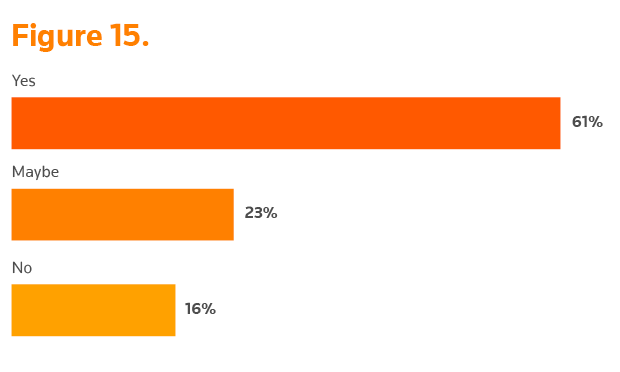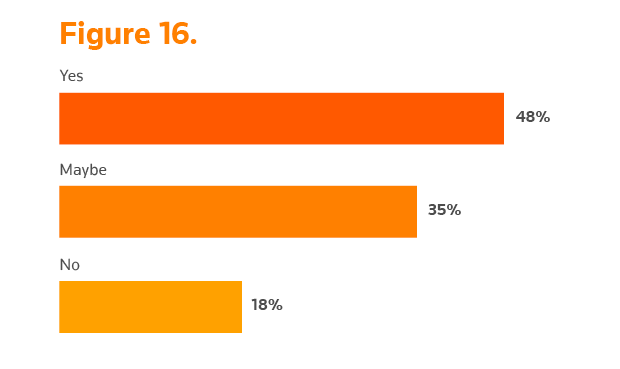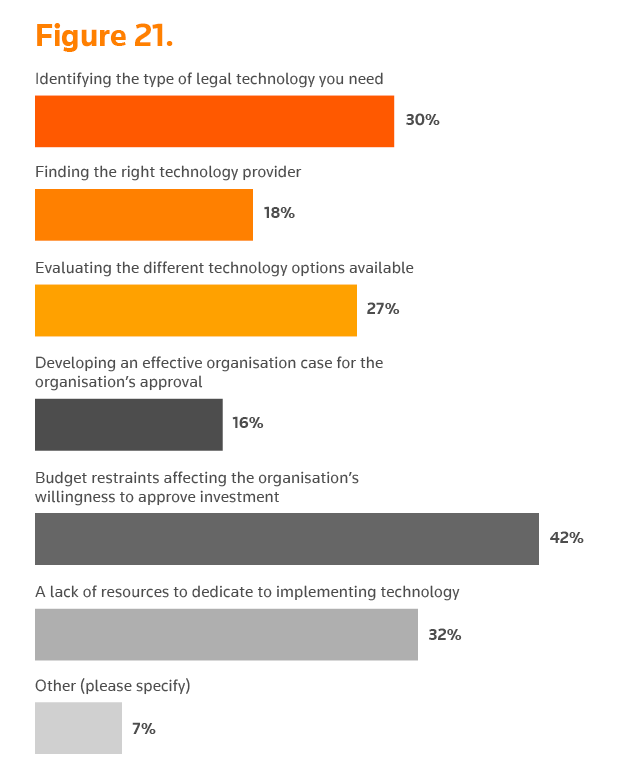Building on the insights from the annual Tech and the Law Report, Thomson Reuters recently held a webinar to speak to its research findings. Webinar host, Rosalie Tordoir, Head of Client Services – HighQ, Asia and Emerging Markets, invited two guest speakers for an in-depth discussion on the survey data and innovation insights seen in the market more generally.
Michael Johnson is Head of Strategy at Momentum Intelligence and undertook the number crunching and data analysis to develop the report. Michael joined Rosalie on the program, speaking to its quantitative insights in a data-storytelling manner.
Rounding out the discussion with unique commentary was none other than Carolyn Austin, Director of Knowledge and Practice Support, Australia, K&L Gates. At K&L Gates, Carolyn leads a team of Australian legal practitioners and specialist technicians focused on creating innovative approaches to client service delivery through sustainable knowledge management, process improvement and digital adoption.
Webinar preview
Click here to watch the webinar on-demand, or continue reading for a recap of the 60-minute session.
Data storytelling and key observations
Attracting legal talent with innovation
A revealing aspect of the report can be found in figure 15, where survey respondents note what they factor into their evaluation of their current employer in the legal profession. Speaking to the findings, Michael observed:
“In Figure 15, this is a pretty clear indication that legal professionals are looking to join organisations and firms that are innovative and are perhaps on the leading edge of tackling new ideas and solving problems,” he said.
When evaluating your current employer, is their level of innovation something you consider?

“Interestingly, looking at this at by the age brackets, I can see that it’s a more common consideration for those between 18-35, with 70% answering yes.”
“Figure 16 gives us insight into whether a lack of perceived ‘innovation’ would ultimately be a ‘deal breaker’ and generally speaking, these results indicate that it could. If we dig a little bit deeper and break out this question by age brackets, we find that for those under 35 years of age it would be, but for those over 35, it would not be as significant a factor.”
Would a lack of legal innovation ever prompt you to move to a new law firm or organisation?

For Carolyn, these results (Figure 15 and 16) really resonate. In Carolyn’s experience at K&L Gates, she’s seen first-hand the influx of many young lawyers and professionals putting their innovative ideas into practice.
“We’ve certainly experienced a groundswell of interest in innovation among the early career lawyers and professionals who have joined our firm,” said Carolyn.
“After experiencing a legal design event, a group of our young lawyers started up their own informal group, meeting over lunch to talk about ways they could apply new ways of working to improve client services.”
This story continues today, as with support and encouragement from the K&L Gates Innovation Committee, the group has gathered more members and calls itself ‘Law Reimagined’. Carolyn spoke about the internal group championing a recent hackathon for seasonal clerks, “which really engaged the new cohort of bright minds in helping solve some real-world legal business challenges”.
“If you empower your lawyers to be curious, to collaborate, and very importantly to be listened to, great things will happen, and I think this generation of lawyers is very interested in working in an environment where innovation is valued”
– Carolyn Austin, Director of Knowledge and Practice Support, Australia
K&L Gates
Buying tech at the right time, all barriers considered
There are many factors that go into choosing the legal tech solution right for your firm organisation. Some decision-makers consider artificial intelligence as a must in their legal research functionalities, while others defer to a list of key features required to deem their collaboration vendor successful.
In the Tech and the Law 2020 Report, we sought to narrow them down and pinpoint the biggest barriers. As Michael explained:
“In Figure 21, the barriers have been ordered to represent the journey that an organisation goes on to adopt or implement new technology.”
What are the biggest barriers for you in gaining access to the legal technology that you need?

“From this we can identify where, along the procurement journey, organisations are likely to come unstuck. These results indicate that the most significant barrier is budget restraints, as we could expect from the results we spoke about earlier [in the webinar] regarding the organisation’s willingness to invest.
“Beyond this however, interestingly there are a significant portion of participants who believe that the identification of the type of technology needed and evaluation of the product providers are also impacting the adoption levels.”
While the survey to compile this report was conducted back in February, it can be expected, in the current climate, that budget constraints may continue to block some firms and legal departments from adopting the right technologies for their needs.
Rosalie invited Carolyn to provide some tips for decision-makers on building a business case for legal tech, when it is indeed needed.
With the current economic forces in play, Carolyn said that budget constraints are likely to be a continuing challenge for law firms and in-house legal teams alike. However, in order to successfully achieve buy-in for the investment, one must look at the bigger picture.
“As the recent events have demonstrated, the right tech at the right time is critical – it’s about seeing it as an investment in the future business of the firm and its clients”
– Carolyn Austin, Director of Knowledge and Practice Support, Australia
K&L Gates
“Decisions to invest in legal technology obviously have to be fiscally responsible, driven by business and client need, and accompanied by a compelling business case that demonstrates the anticipated return on that investment.”
Innovating during the COVID-19 pandemic and beyond
As the report creator, Michael offered the webinar audience some final observations on the Tech and the Law 2020 Report.
“I think as a whole these survey results shine a light on the perception differences within organisations. It’s important to create a culture of innovation and a culture that is comfortable with change”
– Michael Johnson, Head of Strategy, Momentum Intelligence
“But equally important is the meaningful technological adoption that drives the organisation forward by pinpointing user frustrations and using smart technology, processes or systems to improve their organisation’s ability to grow.”
Speaking of growth, Rosalie acknowledged that COVID-19 has had an impact on the profession in a number of ways. She asked Carolyn whether K&L Gates has had to change the way it uses technology to collaborate during the global health crisis.
“In many ways we have been well prepared, through a series of strategic technology investments and business continuity planning, so that the transition has been pretty seamless and very successful,” said Carolyn.
“We are continuing to work on finding new ways to support client services, improve efficiency, and foster a culture that thrives on innovation.”
You can watch our free-to-join webinar at any time, which brings the report to life through the voices of our qualified speakers. Be sure to join us next week as we delve into the ins and outs of virtual work spaces, with The Art of Working Remotely in the Legal Profession.

